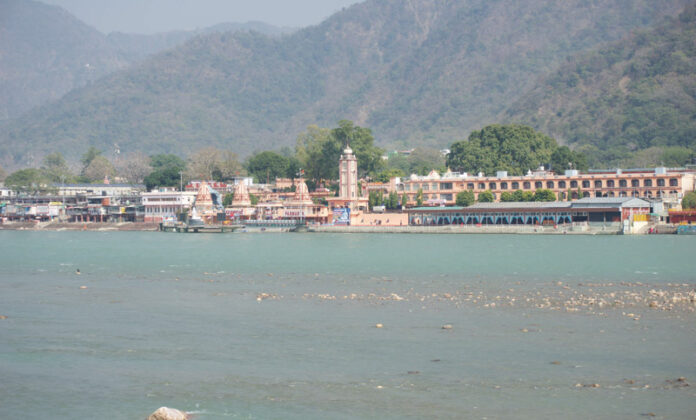By Gurmukh Singh
RISHIKESH (India): Welcome to Rishikesh – the yoga capital of the world – in the foothills of lower Himalayas in Uttarakhand state of India.
When you think of Rishikesh, you think of its iconic Ram Jhula (jhula means suspension bridge), Laxman Jhula, yoga, meditation, temples, ashrams (centres for spiritual studies), the holy river Ganga and its evening aarti.
And the Beatles!
Yes, it was the British rock band Beatles which put this town on the world map when they stayed with transcendental meditation guru Mahesh Yogi here in the 1960s.


A visit to Rishikesh had been on my wish list for a long time. I had visited this region on journalistic assignments, but I could never get past Dehradun because of various reasons.
But this March I decided to sacrifice my Assam visit in favour a quick pilgrimage to this small town scenically nestled on the banks of India’s holiest river Ganga.
Taking a Uttarakhand State Transport Vovlo bus from Delhi’s Kashmere Gate inter-state bus terminus, I landed in Dehradun in the evening to spend a night with my long-term friend Saurabh Malhotra who lives in the posh Indira Nagar Colony of the city. I met Saurabh first in Guwahati during my first trip to the North East in 1996. He had just returned from Berlin after finishing his studies and was helping the poor Assamese people with clothing that had been donated to him by people in Germany.
It was great to reconnect with Saurabh who has now settled in Dehradun where his mother – a retired principal from Delhi – built her home in the city’s posh area.
Since Saurabh was not well, I left alone for Rishikesh the next morning. Once there, I was mesmerized by the serenity of the flowing Ganga, the beauty of forested hills on its banks, and its suspension bridges or jhulas.

So I jumped on to the busy Ram Jhula (suspension bridge) to get across the Ganga to reach its eastern bank where all yoga ashrams, temples, and the Beatles’ meditation caves are.
One could see adventure seekers having fun while rafting in the river as it wended its way past Rishikesh.
Having had my fill of photo shots from the bridge while walking to the eastern bank, I right away waded into the crowds. Most were locals, many were from other states of India and many others were from foreign countries.
I was in the spiritual district of Rishikesh – which means the place of sages. It is traffic-free, alcohol-free and meat-free.



Here ancient ashrams and temples came up ages ago on a stretch of the river bank. Many survive to this day. Many more new yoga ashrams and temples have come up alongside them, with forested Himalayas providing a stunning background to this place.
As I started walking on the crowded street along the river bank, the chants of mantras and the tolling of temple bells filled the air.
As I walked a few steps, I saw a signboard which read: Union of East and West. Indeed, inside that make-shift building, some foreigners were taking meditation classes from their Indian master. Behind that building sat a huge idol of Lord Shiva in the flowing river. During the monsoon flooding, this idol makes a stunning view.
A few steps ahead on my left stood the famous Parmarth Niketan Ashram which is known to yoga seekers all over the world for its International Yoga Week in March. In fact, when I ambled up its entrance, I found out that they were in the middle of International Yoga Week as I could see scores of foreigners with yoga mats hurrying to the back of the ashram for their yoga session.
Also a magnet for spiritual seekers, Parmarth Niketan Ashram is full of touches of ancient Hindu heritage and wisdom.
An Australian follower of this ashram, who works for its Divine Shakti Foundation, filled me in on the year-round activities at this world-famous ashram and how they raise money to run their affairs.
Walking out of Parmarth Niketan Ashram, I made a dash for the other end of the long and dusty street to reach the Beatles’ ashram –which actually is Maharishi Mahesh Yogi Ashram.



Along the street as I passed Gita Bhawan and other temples, I found the Beatles’ name popping up here and there. A jeweller had named his business Beatles Choice! Someone ran a Beatles Cottage!
Then there was the Beatles Street! Big Beatles banners adored a stretch of the river bank. And there was something akin to a Beatles Walk of Fame!
And when I walked up the hill into Maharishi Mahesh Yogi Ashram – a cluster of meditation caves dotting the hilly terrain – the Beatles were all over the place. Since the British rock band came to stay here with Mahesh Yogi in the 1960s, the place is now more famous as the Beatles’ ashram.
A notice board at the entrance says: “Maharishi Mahesh Yogi established this Ashram in 1961 on 7.5 hectares of forest land. Many famous people, including the Beatles, came here to practise Transcendental Meditation.”
A little ahead, another signboard pointed the location and number of the so-called bungalows of the Beatles and their guru Mahesh Yogi. While Mahesh Yogi occupied bungalow number 9, the Beatles meditated in the nearby bungalow number 11.





It felt surreal to walk into these abandoned bungalows and wonder how Maharishi Mahesh Yogi, the Beatles and others meditated in these bungalows – which are actually very small concrete huts with attached toilets and a flight of stairs.
Streams of visitors, mostly Beatles’ fans, walked around this abandoned place, taking pictures and reminiscing about its heyday.
As I walked up and down its cobbled lanes overrun by dense foliage, I felt how this ashram must have been a thriving place 60 years ago.
A big hall – now called Beatles Hall because of the huge drawings of The Fab Four on the walls – where Maharishi Mahesh Yogi must have must met with his large following, reminded the visitors of those times. It is almost in ruins.

Then there ruins are of a printing press which once churned out reams of literature on Transcendental Meditation (TM). A signboard in front of the ruins reads: “Constructed in the early 1960s, this press was used for printing literature on TM. ‘The Science of Being and the Art of Living’ and ‘Maharishi Mahesh Yogi’s commentary on the first 6 chapters of Shrimad Bhagavad Gita’ were printed in this building.”


Not far from the ruins of this printing press lies an abandoned post office. A signboard at its gate also says, “Constructed in the early 1960s, this building was used for official mails by Maharishi ji and by guests staying for residential courses.”
Looking across and down the slopes of this ruined place at the mighty Ganga river flowing away from Rishikesh, I felt a twinge of sadness as I walked out of Maharishi Mahesh Yogi Ashram. Time spares no one!
Walking back to the western bank of the river via the crowded Janki Jhula, I stepped past dozens of langurs to take my final pictures – of Triveni Ghat where nightly aarti is performed in praise of the holy river. Time to leave.
Bye-bye Rishikesh.








